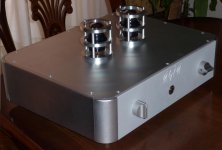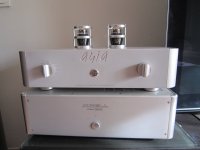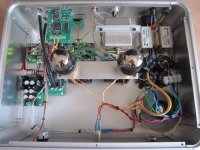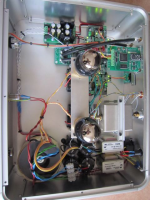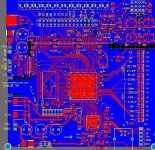@exa065
i was not aware that there is support existing. I can also try that one.
Which version of OSX and Audirvana are you running whithout issues ?
I have the issues with 10.8.2 driver 1.6.0a4 and all of the latest Audirvana versions.
I'm happy to downgrade to Snow Leopard if this would fix the problems i do not need all this icrap on a music server ...
There is no need to go back to Snow Leopard. We develop the drivers on Lion.
- Please download the latest OS X drivers and the Uninstall Script for OS X from our support site.
- Run the Uninstall Script, and reboot.
- Install the latest drivers and Dashboard
- Click on the Dashboard icon on the menu and in the context menu select exaSound 2Ch.
- Download, install and start the latest Audirvana Plus
- Under Audirvana Preferences, Audio System select Preferred Audio Device - exaSound 2Ch
- Make sure that Integer Mode and Direct Mode are NOT checked.
- You can use Exclusive Mode if you like.
Best,
exa065
Volumen control : One or two I2C outputs
The driver supports multiple boards : Do you need to synchronize the clock in the boards.
What I am looking for is a system with two 'black box' dacs connected direct to my power amps, where all the control and display are in the pc, and I only have one usb cable to each dac.
Flemming
The driver does not support two boards. Do you need more than 8 channels?
Yes, if multiple DACs are used, for best results the clocks should be synchronized, If the new board is used in Synchronous mode, this is not a problem. The clocks on the exaU2I will be used as master clocks.
I was afraid the volume control request will come up. We won't be able to do it. It is difficult to implement it with FPGA. We use a different implementation for the e18 and e20 DACs. It is one of the features that makes them more complicated and more expensive.
We have a long list of requests for features, and they are interconnected. For example the exaU2I hardware was not designed for DSD. DSD was enabled with a software hack, and this puts limits to what can be done with a player or driver update. There is no hardware signal to switch the DAC between DSD and PCM modes.
Linux drivers are important, but if the hardware needs an update, the driver development has to wait.
I've been thinking about updates and new features for the exaU2I that can take the sound quality to the next level. We've been working also on the numerous requests to make the next generation device more open to tweaking and DIY experiments.
Am I missing something on the hardware side?
- Just about 1ps jitter
- Two sets of clocks for synchronous and asynchronous operation with ES9018
- 8 channel DSD
- 8 channel DXD / 384 kHz PCM
- Individual LEDs for all PCM and DSD sampling rates
- Easy elimination of USB power
- Macro USB connector
- Header for connecting external USB connector
- Connectors for external power sources
- New ground isolation technology
- Micro BNC output connectors
- Elimination of the USB daughter board
A while ago there was some discussion about hardware and/or software modifications to support interfacing with the PCM1704 (or similar parallel-input DACs). More specifically, you were proposing:
- Change in the output format
- Elimination of GMR jitter
I've searched, but it doesn't seem like that project went anywhere. If it hasn't, please consider the above enhancements for your new board and/or software.
Hi
I present the project AYIA (in tribute to his "perpetrator", Smanz in Diyaudio forum)i. I have not made myself, just so enjoy it.
It is a dual mono dac cv181 tube.
Princiales components are:
- 2 Reference 9018 Sabre DACs (Twisted Pear Audio)
- USB EXAU2I
- Analog output with Psavane cv181 tubes, capacitors Mundorf MCAP gold silver oil, transformer Sowter
- Inputs 1 USB (exau2i), 2 Digital coaxial (75 Ohm WBT), 1 Toslink, 1 BNC.
- Outputs RCA analog outputs (WBT) Balanced (Furutech)
The sound is realistic, three-dimensional (in untreated room) and detailed. I've never heard anything like it, and is still running.
The output selector allows dsd for exadevices dsd player.
People who have heard talk sound much better than more expensive commercial dacs (and is not cheap)
Is everything perfect, I just need to get exadevices Audirvana direct mode
Some pictures:
Imageshack - img2078e.jpg
Imageshack - img2079n.jpg
Imageshack - p1010106il.jpg
Best, Jorge.
I present the project AYIA (in tribute to his "perpetrator", Smanz in Diyaudio forum)i. I have not made myself, just so enjoy it.
It is a dual mono dac cv181 tube.
Princiales components are:
- 2 Reference 9018 Sabre DACs (Twisted Pear Audio)
- USB EXAU2I
- Analog output with Psavane cv181 tubes, capacitors Mundorf MCAP gold silver oil, transformer Sowter
- Inputs 1 USB (exau2i), 2 Digital coaxial (75 Ohm WBT), 1 Toslink, 1 BNC.
- Outputs RCA analog outputs (WBT) Balanced (Furutech)
The sound is realistic, three-dimensional (in untreated room) and detailed. I've never heard anything like it, and is still running.
The output selector allows dsd for exadevices dsd player.
People who have heard talk sound much better than more expensive commercial dacs (and is not cheap)
Is everything perfect, I just need to get exadevices Audirvana direct mode
Some pictures:
Imageshack - img2078e.jpg
Imageshack - img2079n.jpg
Imageshack - p1010106il.jpg
Best, Jorge.
Dear flemming3520,
It's very nice to have your post on this thread again!
Your post on DSD256 and DSD512, more than 1 year ago, on this thread inspired me to explorer DSD256 and DSD512. Based on your indication, I could create DSD256 and DSD512 source files from PCM 44.1kHz/16bit files. Playing DSD256 files on ES9018 has brought me the best sounds that I ever have. I really owe to you.
By the way, have you establish a noise-free DSD512 play method with ES9018?
I'm now trying that. However, I think it's a very tough challenge.
Best regards,
Bunpei
It's very nice to have your post on this thread again!
Your post on DSD256 and DSD512, more than 1 year ago, on this thread inspired me to explorer DSD256 and DSD512. Based on your indication, I could create DSD256 and DSD512 source files from PCM 44.1kHz/16bit files. Playing DSD256 files on ES9018 has brought me the best sounds that I ever have. I really owe to you.
By the way, have you establish a noise-free DSD512 play method with ES9018?
I'm now trying that. However, I think it's a very tough challenge.
Best regards,
Bunpei
Playing DSD256 files on ES9018 has brought me the best sounds that I ever have.
Would that mean that even converted PCM sounds better as DSD256?
Hi
I present the project AYIA (in tribute to his "perpetrator", Smanz in Diyaudio forum)i. I have not made myself, just so enjoy it.
It is a dual mono dac cv181 tube.
Princiales components are:
- 2 Reference 9018 Sabre DACs (Twisted Pear Audio)
- USB EXAU2I
- Analog output with Psavane cv181 tubes, capacitors Mundorf MCAP gold silver oil, transformer Sowter
- Inputs 1 USB (exau2i), 2 Digital coaxial (75 Ohm WBT), 1 Toslink, 1 BNC.
- Outputs RCA analog outputs (WBT) Balanced (Furutech)
The sound is realistic, three-dimensional (in untreated room) and detailed. I've never heard anything like it, and is still running.
The output selector allows dsd for exadevices dsd player.
People who have heard talk sound much better than more expensive commercial dacs (and is not cheap)
Is everything perfect, I just need to get exadevices Audirvana direct mode
Best, Jorge.
Great project, Jorge. Congratulations!
I will email Damien from Audirvana one more time. I need his help for enabling direct mode. Here are the pictures from your post, embedded here for easy viewing.
Cheers!
exa065
Attachments
Would that mean that even converted PCM sounds better as DSD256?
I find the claims for benefits from conversion / up sampling of PCM to DSD exaggerated. In my personal experience best results are achieved when every source is played in its native format. Great DSD recordings sound great when played without conversion to PCM. Great PCM sources sound great the way they are - in PCM format. Until there are DSD512 recordings available for download, it is wiser to spend your money on better amplifiers and speakers, or room treatment.
....More specifically, you were proposing:
See here: exaU2I - Custom Build for Use With PCM1704
- Change in the output format
- Elimination of GMR jitter
I've searched, but it doesn't seem like that project went anywhere. If it hasn't, please consider the above enhancements for your new board and/or software.
Elimination of GMR jitter is one of the main improvements for the new exaU2I. The output jitter will be pretty much the jitter of the clocks - 1ps.
We can have the same hardware supporting the PCM1704 input format with an alternative firmware. It can be offered as a separate product. There will be no oversampling, you will have to use a third party software or hardware oversampling filter.
Would that mean that even converted PCM sounds better as DSD256?
Yes, a DSD256 source converted from PCM sounds definitely better than its original PCM as long as I use Sony "DSD Direct" software for the conversion.
I guess an upsampling FIR filter and a delta-sigma modulator employed in the software might be superior than hardware implemented ones in DAC chips.
Yes, a DSD256 source converted from PCM sounds definitely better than its original PCM as long as I use Sony "DSD Direct" software for the conversion.
I guess an upsampling FIR filter and a delta-sigma modulator employed in the software might be superior than hardware implemented ones in DAC chips.
- Is the conversion PCM -> DSD256 lossless?
- Is there an objective proof that it is lossless?
- Can you convert back to PCM and get an identical binary file image?
- If not how do you know if it is sounds "better" or "different"?
- How much fidelity is lost on the lossy conversion, to have an non-quantifiable gain based on the guess that "an upsampling FIR filter and a delta-sigma modulator employed in the software might be superior than hardware implemented ones in DAC chips" ?
Dear exa065,
I think it's meaningless to stick to "lossless-ness" of PCM to DSD256 conversion because PCM -> DSD256 and DSD256 -> PCM conversion are not mutually reversible mathematical processes. (If you can't agree with my opinion, I hope you will read this book " Understanding Delta-Sigma Data Converters")
ES9018 DAC chip converts PCM input signals to 6-bit delta-sigma modulated signals before applying internal DAC section. Do you stick to "lossless-ness" of the process in the DAC chip?
Anyway, I wish the new exaU2I board maintains the capability of DSD256 & DSD512 play. I think no consumer or DIY products other than exaU2I support a DSD512 play. Your exaU2I is obviously a world-record holder on this point and I think it is very valuable feature. Just recently, my Japanese friend purchased one exaU2I because he wanted to try DSD512.
Best regards,
Bunpei
I think it's meaningless to stick to "lossless-ness" of PCM to DSD256 conversion because PCM -> DSD256 and DSD256 -> PCM conversion are not mutually reversible mathematical processes. (If you can't agree with my opinion, I hope you will read this book " Understanding Delta-Sigma Data Converters")
ES9018 DAC chip converts PCM input signals to 6-bit delta-sigma modulated signals before applying internal DAC section. Do you stick to "lossless-ness" of the process in the DAC chip?
Anyway, I wish the new exaU2I board maintains the capability of DSD256 & DSD512 play. I think no consumer or DIY products other than exaU2I support a DSD512 play. Your exaU2I is obviously a world-record holder on this point and I think it is very valuable feature. Just recently, my Japanese friend purchased one exaU2I because he wanted to try DSD512.
Best regards,
Bunpei
We can have the same hardware supporting the PCM1704 input format with an alternative firmware. It can be offered as a separate product. There will be no oversampling, you will have to use a third party software or hardware oversampling filter.
Thank you! One of the advantages of your device (as opposed to other ones that only handle 192kHz) is that I can do 8x oversampling of CD audio in software with the PCM1704. That's a huge benefit for me. I'm looking forward to your new hardware.
BTW, there are a lot of people who run the PCM1704 is NOS (non-oversampling) mode as well, with either a first or third order analog filter. I'm sure they'd be candidates for purchasing a board with alternative firmware as well.
the fifo main problem is
A. no multichannel at this stage
B. no DSD
C. the delay
These problems are irrelevant for most users.
These problems are irrelevant for most users.
I guess that is qusp's point
Sorry qusp, I had to delete your last two posts because of the disrespectful tone. They were on display for a while, so people can see them. Going forward I intend to keep the discussion here focused on the support of our users and the development and the improvement of the exaDevices products.
These problems are irrelevant for most users.
But not for all users. As an exa owner I've used the DSD, appreciate the low delay (infact Ive used it with Logic on osx quite a few times), and have considered using the multichannel aspect for a pc based crossover. Different strokes for different folks.
Here is again an updated list of features for the next generation exaU2I:
Cheers,
exa065
- Just about 1ps jitter
- Two sets of clocks for synchronous and asynchronous operation with ES9018
- 8 channel DSD
- 8 channel DXD / 384 kHz PCM
- Individual LEDs for all PCM and DSD sampling rates
- Easy elimination of USB power
- Macro USB connector
- Header for connecting external USB connector
- Connectors for external power sources
- New ground isolation technology
- Micro BNC output connectors
- Elimination of the USB daughter board
- No need to rewire the outputs for DSD and PCM (ES9018 only)
- I2C header for ES9018 volume control - if we can make it.
- Multichannel support for PCM1704. This option will rewire alternative firmware, and it may be a separate product.
- ES9018, PCM1704 or a third party DAC.
- Let us know your priorities - all in one board or multiple specialized products for lower cost
- Asynchronous operation (only two clocks) or all clocks installed.
- Two channel only, PCM only etc.
Cheers,
exa065
Attachments
- Home
- More Vendors...
- exaDevices
- exaU2I - Multi-Channel Asynchronous USB to I2S Interface
